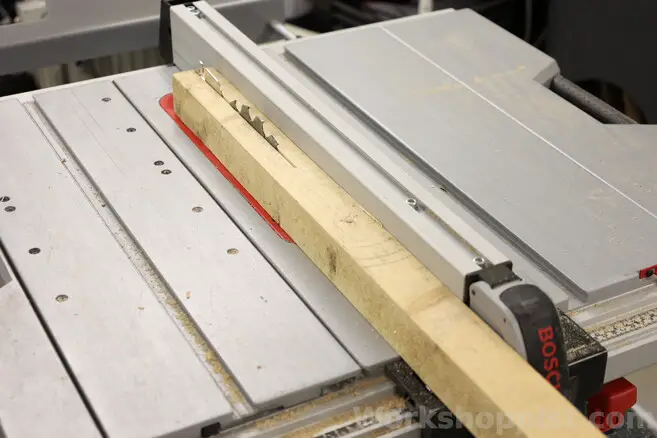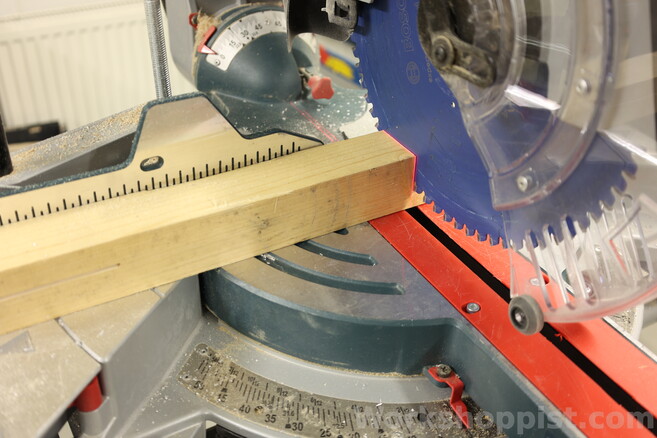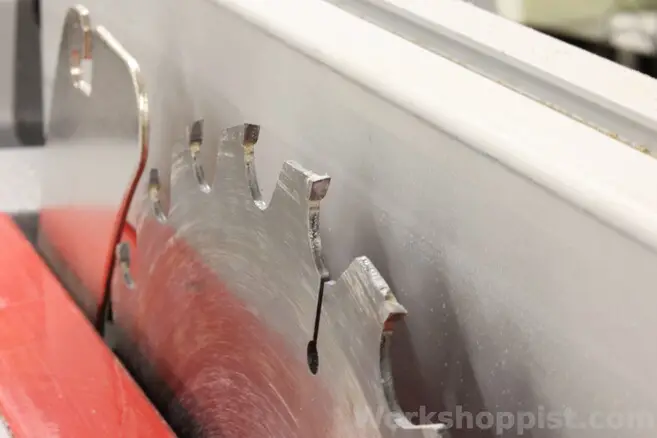“You rip a board along the length, and you cross-cut it to length.” This rule gets you straight most of the time. But is exactly true? How do ripping and cross-cuts really differ? Can you do both with the same saws?
This article tells what you need to know about ripping and cross-cutting. Ripping means cutting a piece of wood in the same direction as the grain, i.e. along the grain, while cross-cutting is cutting perpendicular to the grain, i.e. across the grain. Ripping cuts are usually longer than cross-cuts, take less power, have a rougher finish, more prone to blade drift and prefer a chisel-like tooth shape; cross-cuts are shorter, harder, smoother and more precise, and prefer knife-like teeth.
Next, we will go through the main differences between the two cut types, which are also summarized in the table below. If you interested in a deeper understanding of ripping and cross-cutting, read on!
What does Ripping vs. Cross-cutting mean?

Ripping means splitting a piece of wood in two along the wood grain. Wood grain is the direction of the fibers in the wood, so in ripping you cut “between the fibers”.
Cross-cutting means splitting a piece of wood across the wood grain. A cross-cut cuts right against the wood fibers, and is typically harder than ripping.

Rip/cross-cut and workpiece dimensions
Most lumber has the grain running along the longer dimension of the piece. So with boards, planks and beams, you usually rip along the length of the piece and you cross-cut across the width.
But note that the workpiece dimensions do not define whether a cut is a rip-cut or a cross-cut.
Why is ripping easier than cross-cutting?
Ripping is an intrinsically lighter cut to make since only weak across-fiber bonds in the wood have to be broken. Cross-cutting takes more energy since the strong cellulose wood fibers themselves have to be cut.
An example: Consider how easily an axe splits wood along the grain when you are making firewood, but how much harder it is to cut the tree trunk in felling.
Ripping vs. cross-cutting with a saw?
Ripping cuts with a saw usually take less power than cross-cuts, but the difference is smaller than theoretically expected.
The reason is that most saws must do some fiber-cutting in ripping cuts. How much – depends on the cut orientation and saw tooth geometry.
At a the saw tooth level, the cutting mode is always mixed: there is both fiber-cutting and cutting between fibers going on. Ripping cuts just go typically more between fibers, and cross-cuts more against fibers.
Some ripping cuts can be harder than cross-cuts. An example is chainsaw milling, where the chainsaw chain eats into the wood from the end of the log. The chain top plates are actually cutting wood fiber over and over again.
Which saw for ripping/cross-cutting?
Most saws can do both ripping and cross-cutting, but are often predominantly used for one cut type.
An example of a ripping saw is the table saw, which is mostly used in resizing lumber. A miter saw, on the other hand, is the epitome of a cross-cut saw.
Both table and miter saws can do ripping and cross-cutting. In fact, the saws favor one cut type because of workpiece dimensions, not grain orientation.

Ripping and cross-cutting saw blades
Ripping cuts and cross-cuts are best done with different slightly different saw tooth geometries.
Ripping cuts favor a chisel-like cutter geometry and large teeth (low TPI). Chisel teeth are efficient in removing material from the bottom of a ripping cut where only weak between-fiber ties are to be broken. The weak ties also allow each tooth to take a deeper cut, for which large widely spaced teeth are optimal.
Cross-cuts favor a knife-like cutter geometry and small teeth (high TPI). Wood fibers need to be cut here on both sides of the kerf, and alternating pointed knife cutters are efficient in doing this. The tough fiber-cutting is best done with smaller teeth and dense spacing.
Saws may be equipped with a blade optimized for ripping or cross-cutting, or both. Most circular saws (table, track, miter) come with a general-purpose blade that is a compromise between ripping and cross-cutting, since changing blades between cuts is not usually practical.
Ripping vs. cross-cutting chain?
Chainsaws can also be fitted with a chain optimized for either cross-cutting or ripping.
Most chainsaw chains are cross-cutting chains; this is the regular or standard chain. The reason is that chainsaws are predominantly used in cross-cuts.
Ripping chains are a specialty chain with application mainly in chainsaw milling. Ripping chains differ from regular chains mainly in a lower sharpening angle between 5 and 10 degrees. Even with a ripping chain, a chainsaw is not a very efficient ripping saw.
For more info on ripping chains, see my earlier article on the topic.
Rip vs. cross-cut in sheet goods?
With sheet goods, ripping and cross-cutting refer to cuts along the sheet length and width, respectively.
Ripping and cross-cutting are actually not properly defined with sheet goods. The reason is that wood-based sheet products have grain running in many directions: plywood has wood grain running in two directions and particleboard has grain running in almost all directions! With plywood, you are always both ripping and cross-cutting at the same time.
The terms ripping and cross-cutting are still used with sheets goods to refer to cuts along the sheet length and width, respectively. That is, a cut is called a rip cut if it goes along the longer axis of the sheet, and a cross-cut if it goes in the shorter direction – regardless of the grain.
Precision in ripping vs. cross-cutting
Dimensional accuracy and surface finish are often lower in ripping cuts than in cross-cuts.
The reason to lower accuracy in ripping is blade drift, which means the tendency of the saw blade to veer to either side during the cut. Blade drift is more common in rip-cuts because these cuts are often oriented slightly oblique to the wood grain. In such situations, a saw blade has a tendency to “follow the grain”, i.e. drift to the same side that the grain is going. Saws with flexible blades (e.g. band saw) are most susceptible; stiffer circular saw blades not so much.
Ripping cut surfaces are often also rougher than cross-cut surfaces. The reason to this is hairy fiber pullout from the cut side as well as easier side-stepping of individual teeth into the “soft” direction of the cut side face.
Summary
| RIP VS. CROSS-CUT | Ripping cut | Cross-cut |
|---|---|---|
| Means: | along grain | across grain |
| Length (typ.): | many ft. | 1”…12” |
| Saw types: | table saw band saw circular saw | miter saw hand saw handheld circular saw |
| Cutting resistance: | lower | higher |
| Tooth shape: | chisel | knife |
| TPI: | low | high |
| Blade drift: | may occur | usually none |